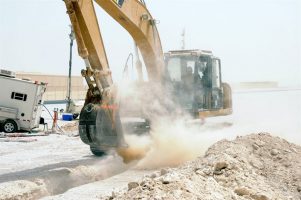Dust to Dust: A Look at Silica Dust FAQs

Ever since OSHA began enforcing its respirable crystalline silica standard for general industry in June 2018, employers have struggled to understand compliance requirements. In late January, OSHA published a list of Frequently Asked Questions (FAQs) and answers developed with industry stakeholders to relieve some of the confusion.
The silica standard establishes a permissible exposure limit (PEL) of 50 μg/m3 as an eight-hour time-weighted average (TWA), and an action level of 25 μg/m3, calculated as an eight-hour TWA. Employers must ensure that employees are not exposed to respirable crystalline silica (RCS) above the PEL.
Exposure assessments must be completed by employers on each employee who is, or may reasonably be expected to be, exposed to RCS at or above the action level and provide medical surveillance for employees who are exposed to RCS at or above the action level for 30 or more days per year. Employers also must establish regulated areas and provide respiratory protection, housekeeping, training, hazard communication and medical surveillance.
Clarifying Exposure Prevention
It must be ensured that no employee is exposed to an airborne concentration of silica in excess of the PEL. To assess airborne concentration, employers must monitor employee exposure through either a performance or scheduled monitoring option.
Employers must establish regulated areas from the rest of the workplace and post signs with a specified legend at all entrances to those areas. Access to regulated areas must be limited and require the use of a respirator for each person who enters it. If an employer enforces work rules limiting employees’ time in a regulated area, and there is no reasonable expectation that their eight-hour TWA exposures will exceed the PEL, the regulated area does not need to be demarcated.
Administrative controls are an acceptable means of reducing employee exposures. An employer could reduce an employee’s exposures by scheduling high-exposure tasks to be conducted when that employee is not working in an adjacent area. Rotation of employees to limit employee exposures also is not prohibited.
This information, of course, represents just a portion of the clarifications offered by OSHA in its FAQs. The full silica FAQs are available here.
Blog Posts
Latest Posts
Related Posts




